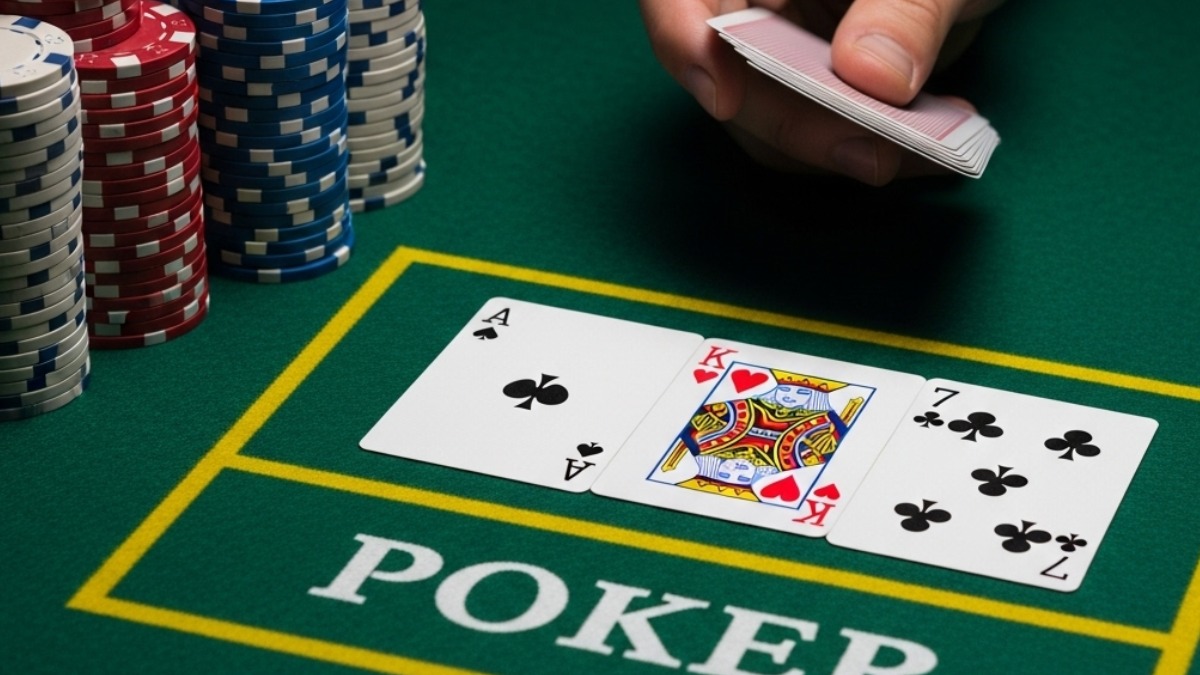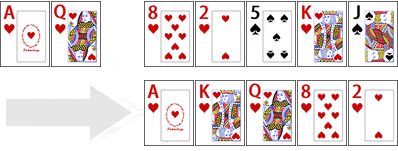
Poker Hand Rankings – Complete Beginner’s Guide to Winning Hands
Mastering poker hand rankings is the first crucial step to becoming a confident player. Each traditional poker hand contains five cards, arranged in a universally recognized hierarchy — the rarer the hand, the stronger its value.
For example, two pairs will always outrank a single pair, while a flush will reliably defeat a straight.
In this beginner-focused guide, we’ll explain the official poker hand order, outline how to settle ties, and show you how to quickly identify winning hands. By the end, you’ll know which hands dominate the game and why — equipping you with the skills to compete at any poker table.
Poker Hands (from Best to Worst)
Be sure to pay close attention and memorize the poker hand rankings. Let’s start with the best possible hand in poker….
Royal Flush

A Royal Flush consists of the Ace, King, Queen, Jack, and 10, all of the same suit. All suits are equal in poker. In games using community cards (like Texas Hold’em), if two players share the same royal flush, they split the pot — but in most formats, only one royal flush can exist on the board, making this scenario extremely rare.
Straight Flush

Five cards of the same suit, in sequence. This example shows a Jack high straight flush. If two or more players hold a straight flush, then it is the highest one wins. For example, a Queen high straight flush beats a Jack high straight flush. You will notice that this is very similar to a Royal flush, and that’s because a Royal flush is in fact an ace high straight flush – but it’s given its very own ranking.
Four of a Kind

This hand contains four cards of the same rank/value. This example shows four 8’s, plus a 5 (remember that all poker hands must have five cards). If two or more players have four of a kind, the highest set wins (e.g., four 9’s beats four 8’s). If players share the same four of a kind — possible in community card games — the winner is determined by the kicker (the highest fifth card). If the kicker is also tied, the pot is split. So a player with four 8’s and a 6 would beat a player with four 8’s and a 5.
Full House

A full house in poker combines three cards of the same rank with a separate pair. For example, three 10s with a pair of 7s. The strength of a full house is decided by the rank of the three matching cards—so three Jacks with a pair of 7s beats three 10s with 7s. If multiple players share the same three of a kind, often through community cards, the higher pair (the kicker) determines the winner. When both the trio and the pair are identical, the pot is split. For instance, three 10s with a pair of 8s outranks three 10s with 7s.
Flush

Five cards of the same suit in any order. Our example shows a Queen high flush. If two or more players have a flush, the player with the highest-ranked card wins. If tied, compare the next highest cards, one by one. If all five cards are identical in rank (possible in community card games), the pot is split.
Straight

This hand contains five unsuited cards in sequence. Our example shows a King high straight. In the event of a tie, the best straight is determined by the highest-ranked card. A straight consisting of 8, 9, 10, J, Q would lose to our example hand. But a straight consisting of 10, J, Q, K, A, would win. Also note that an Ace can be used as the low card in a straight (A, 2, 3, 4, 5), but this is the lowest possible straight and would lose to any higher straight, such as 2, 3, 4, 5, 6 or higher.
Three of a Kind

Three cards of the same rank and two unrelated cards. Our example shows three 4’s. Three 5’s would beat our example hand, three 6’s would beat three 5’s, and so on. If players share the same three cards, then the value of the highest unrelated card would count, and if necessary, the value of the second unrelated card. So, three 4’s with Jack, 8, would beat our example hand. As would three 4’s and 10, 9 (because 9 is higher than 8).
Two Pair

Two cards of matching rank, with another two cards of another rank, plus an additional card. In the event of a tie, the highest pair wins. If players share the same highest pair, then the value of the next pair wins. For example, a pair of Aces and a pair of 6’s would beat our example hand, as would a pair of Kings and a pair of 7’s. If two or more players share the same two pair, then the value of the fifth card counts. So, a pair of Kings, a pair of 6’s, with a 4, would beat our example hand.
One Pair

A paired hand contains two cards of matching rank, plus three additional cards. The value of the pair determines who wins in the event of a tie. For example, a pair of 10’s beats our example hand. If players share the same pair, then the best hand is determined by the value of the highest additional card. If this is the same, then it goes to the second card, and if necessary, the third. So, a pair of 9’s with an Ace, 2, and 10 would beat our example hand. As would a pair of 9’s, King, 10, and a 3.
High Card

If a hand doesn’t fall into any of the above categories, then it is judged on the value of the highest ranked card among the five. In this example we have a hand which is Queen high. If players share the same highest card, then it goes to the value of the 2nd, 3rd, 4th, and even 5th card if necessary. A hand with Queen, 10, 9, 5, 4 would beat a hand of Queen, 10, 8, 6, 3 due to the higher third card. If all five cards are the same (highly unlikely), the pot is split.
Community Cards
In poker, every hand is made up of five cards—but many popular variations give players access to more than that. Take Texas Hold’em, for instance: each player receives two private hole cards and shares access to five community cards placed face-up on the table. That gives each player seven cards to work with, but only the best five-card combination counts toward their final hand. Here’s how it works in practice:
In the above example, the best five cards among total of seven (two private cards and five community cards) would be combined to make a flush.
Set to Play Poker?
Poker hand rankings form the foundation of every game, so it’s crucial to learn them until they become automatic. While hand values can shift slightly depending on the poker variant or table size, the universal order of rankings is essential knowledge for all players.
To help you along, we’ve provided a printable poker hand rankings chart you can use as a quick reference. With practice and experience, recognizing the best hands will become second nature. Once you’ve got these rankings locked in, you’re ready to move on to the next lesson!